Effective Team Work and Communication Assessment 1
VerifiedAdded on 2023/06/18
|10
|2631
|112
AI Summary
This report discusses different models of communication and their role in facilitating effective workplace communication. It also describes communication skills which impact business communication and provides an example of poor workplace communication and ways to enhance business communication. The report concludes that communication models can be applied by business firms to improve situations with poor business communication.
Contribute Materials
Your contribution can guide someone’s learning journey. Share your
documents today.
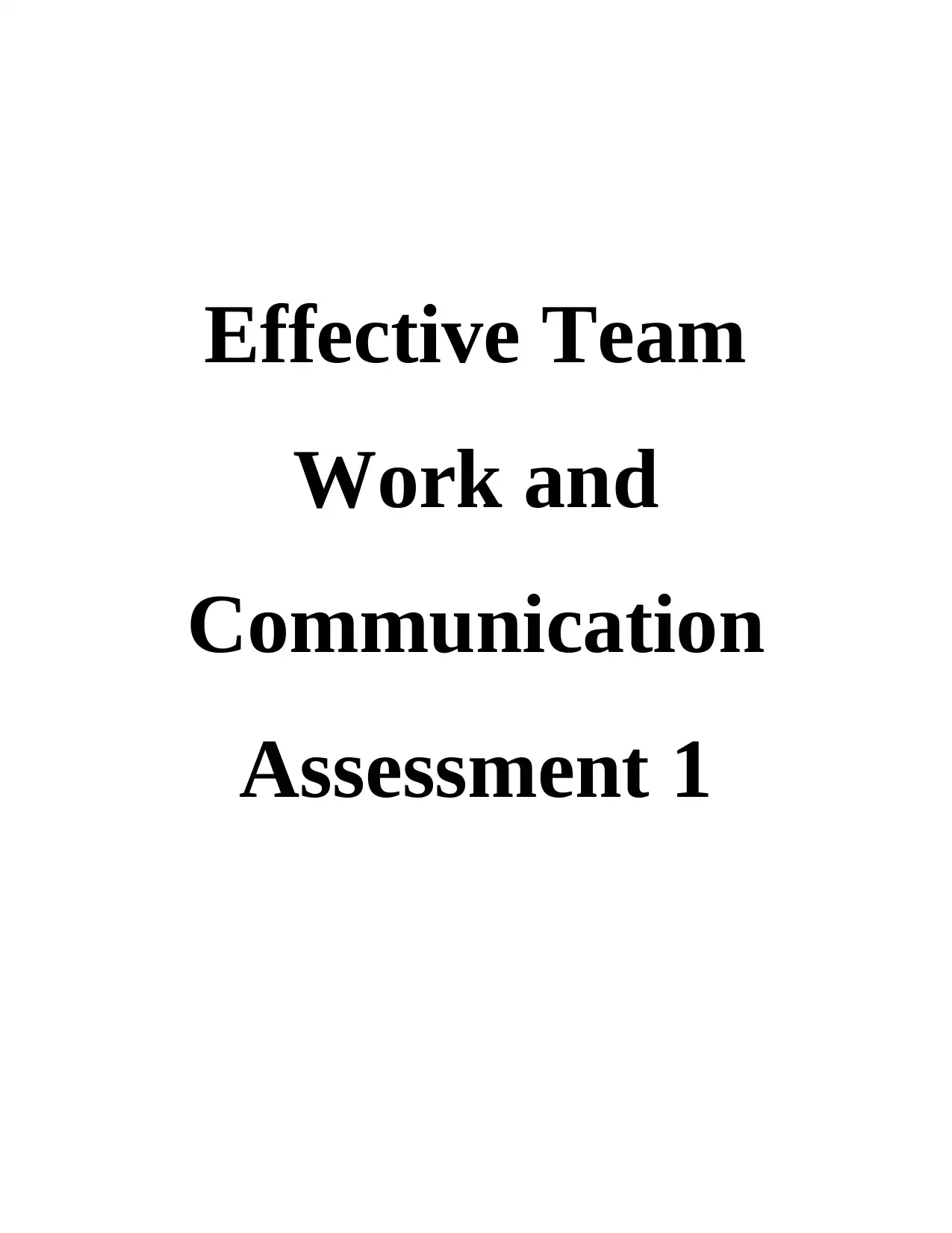
Effective Team
Work and
Communication
Assessment 1
Work and
Communication
Assessment 1
Secure Best Marks with AI Grader
Need help grading? Try our AI Grader for instant feedback on your assignments.
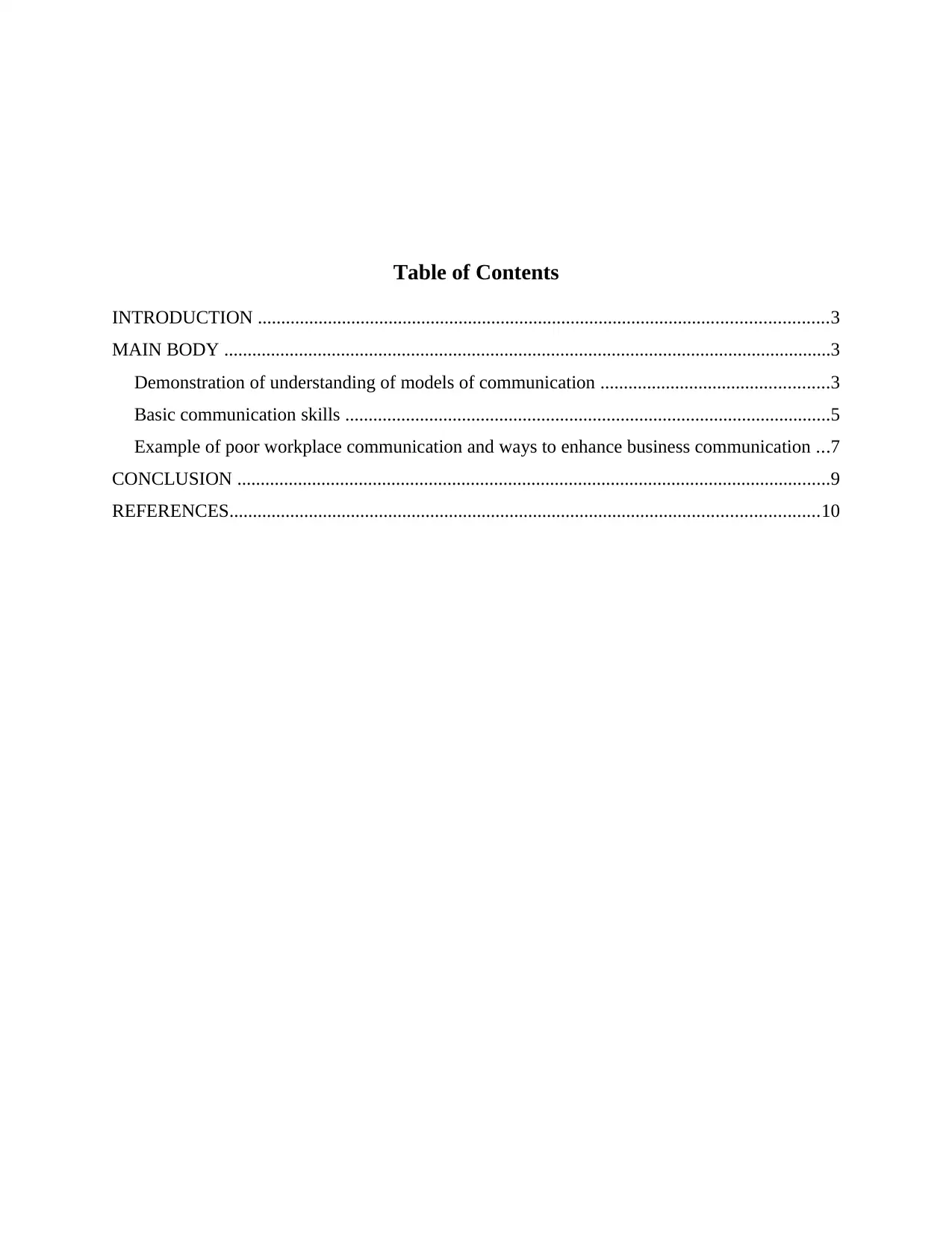
Table of Contents
INTRODUCTION ..........................................................................................................................3
MAIN BODY ..................................................................................................................................3
Demonstration of understanding of models of communication .................................................3
Basic communication skills ........................................................................................................5
Example of poor workplace communication and ways to enhance business communication ...7
CONCLUSION ...............................................................................................................................9
REFERENCES..............................................................................................................................10
INTRODUCTION ..........................................................................................................................3
MAIN BODY ..................................................................................................................................3
Demonstration of understanding of models of communication .................................................3
Basic communication skills ........................................................................................................5
Example of poor workplace communication and ways to enhance business communication ...7
CONCLUSION ...............................................................................................................................9
REFERENCES..............................................................................................................................10
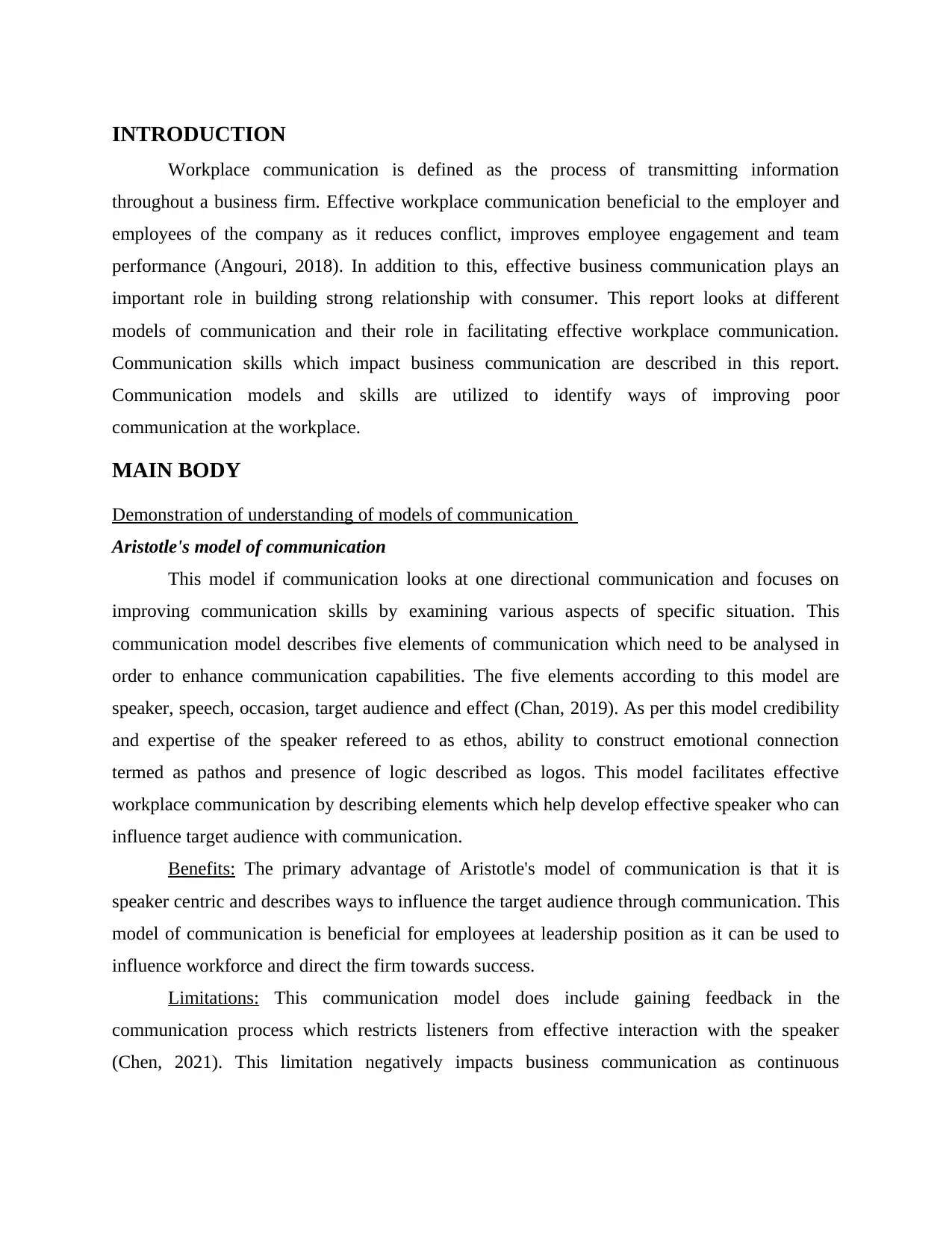
INTRODUCTION
Workplace communication is defined as the process of transmitting information
throughout a business firm. Effective workplace communication beneficial to the employer and
employees of the company as it reduces conflict, improves employee engagement and team
performance (Angouri, 2018). In addition to this, effective business communication plays an
important role in building strong relationship with consumer. This report looks at different
models of communication and their role in facilitating effective workplace communication.
Communication skills which impact business communication are described in this report.
Communication models and skills are utilized to identify ways of improving poor
communication at the workplace.
MAIN BODY
Demonstration of understanding of models of communication
Aristotle's model of communication
This model if communication looks at one directional communication and focuses on
improving communication skills by examining various aspects of specific situation. This
communication model describes five elements of communication which need to be analysed in
order to enhance communication capabilities. The five elements according to this model are
speaker, speech, occasion, target audience and effect (Chan, 2019). As per this model credibility
and expertise of the speaker refereed to as ethos, ability to construct emotional connection
termed as pathos and presence of logic described as logos. This model facilitates effective
workplace communication by describing elements which help develop effective speaker who can
influence target audience with communication.
Benefits: The primary advantage of Aristotle's model of communication is that it is
speaker centric and describes ways to influence the target audience through communication. This
model of communication is beneficial for employees at leadership position as it can be used to
influence workforce and direct the firm towards success.
Limitations: This communication model does include gaining feedback in the
communication process which restricts listeners from effective interaction with the speaker
(Chen, 2021). This limitation negatively impacts business communication as continuous
Workplace communication is defined as the process of transmitting information
throughout a business firm. Effective workplace communication beneficial to the employer and
employees of the company as it reduces conflict, improves employee engagement and team
performance (Angouri, 2018). In addition to this, effective business communication plays an
important role in building strong relationship with consumer. This report looks at different
models of communication and their role in facilitating effective workplace communication.
Communication skills which impact business communication are described in this report.
Communication models and skills are utilized to identify ways of improving poor
communication at the workplace.
MAIN BODY
Demonstration of understanding of models of communication
Aristotle's model of communication
This model if communication looks at one directional communication and focuses on
improving communication skills by examining various aspects of specific situation. This
communication model describes five elements of communication which need to be analysed in
order to enhance communication capabilities. The five elements according to this model are
speaker, speech, occasion, target audience and effect (Chan, 2019). As per this model credibility
and expertise of the speaker refereed to as ethos, ability to construct emotional connection
termed as pathos and presence of logic described as logos. This model facilitates effective
workplace communication by describing elements which help develop effective speaker who can
influence target audience with communication.
Benefits: The primary advantage of Aristotle's model of communication is that it is
speaker centric and describes ways to influence the target audience through communication. This
model of communication is beneficial for employees at leadership position as it can be used to
influence workforce and direct the firm towards success.
Limitations: This communication model does include gaining feedback in the
communication process which restricts listeners from effective interaction with the speaker
(Chen, 2021). This limitation negatively impacts business communication as continuous
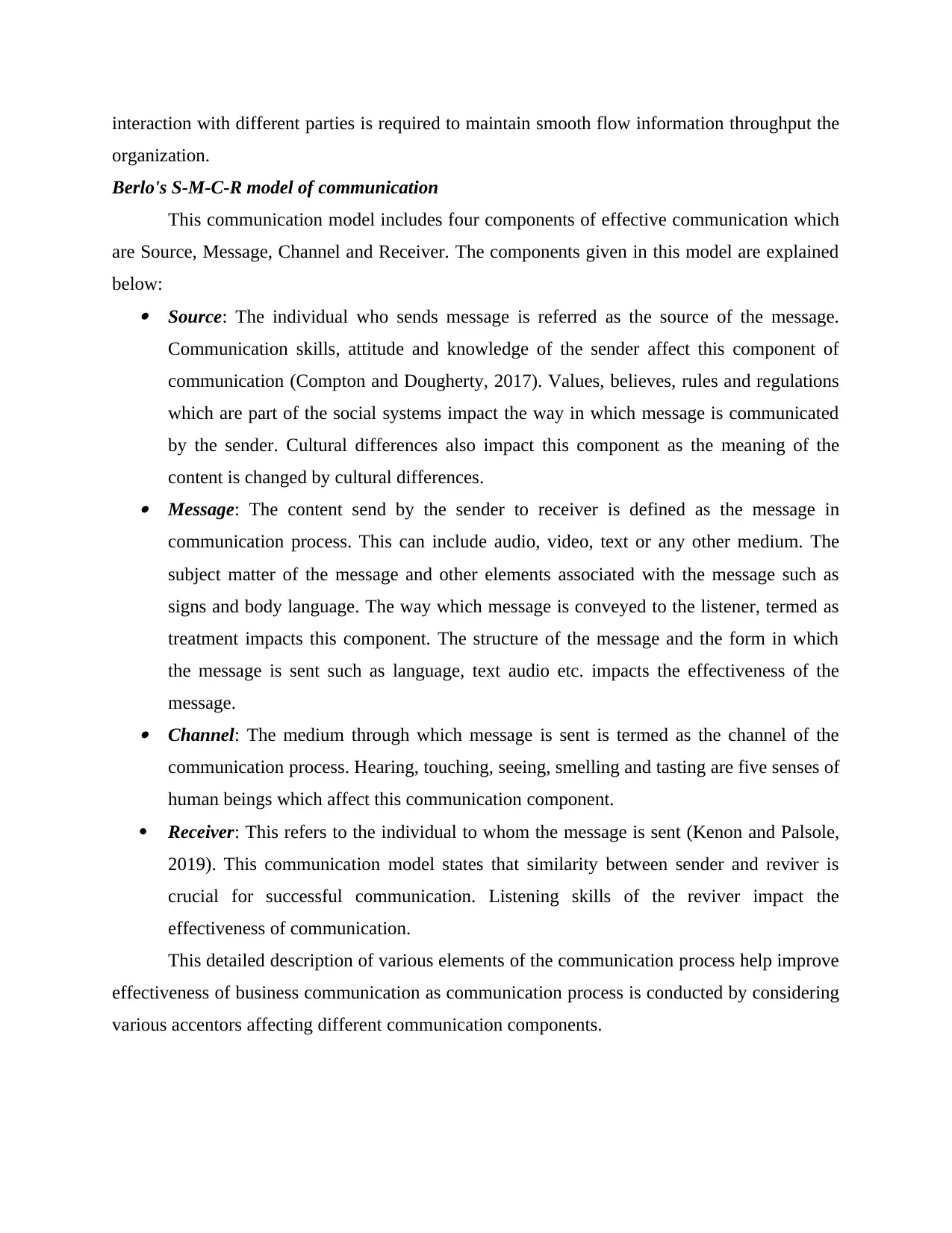
interaction with different parties is required to maintain smooth flow information throughput the
organization.
Berlo's S-M-C-R model of communication
This communication model includes four components of effective communication which
are Source, Message, Channel and Receiver. The components given in this model are explained
below: Source: The individual who sends message is referred as the source of the message.
Communication skills, attitude and knowledge of the sender affect this component of
communication (Compton and Dougherty, 2017). Values, believes, rules and regulations
which are part of the social systems impact the way in which message is communicated
by the sender. Cultural differences also impact this component as the meaning of the
content is changed by cultural differences. Message: The content send by the sender to receiver is defined as the message in
communication process. This can include audio, video, text or any other medium. The
subject matter of the message and other elements associated with the message such as
signs and body language. The way which message is conveyed to the listener, termed as
treatment impacts this component. The structure of the message and the form in which
the message is sent such as language, text audio etc. impacts the effectiveness of the
message. Channel: The medium through which message is sent is termed as the channel of the
communication process. Hearing, touching, seeing, smelling and tasting are five senses of
human beings which affect this communication component.
Receiver: This refers to the individual to whom the message is sent (Kenon and Palsole,
2019). This communication model states that similarity between sender and reviver is
crucial for successful communication. Listening skills of the reviver impact the
effectiveness of communication.
This detailed description of various elements of the communication process help improve
effectiveness of business communication as communication process is conducted by considering
various accentors affecting different communication components.
organization.
Berlo's S-M-C-R model of communication
This communication model includes four components of effective communication which
are Source, Message, Channel and Receiver. The components given in this model are explained
below: Source: The individual who sends message is referred as the source of the message.
Communication skills, attitude and knowledge of the sender affect this component of
communication (Compton and Dougherty, 2017). Values, believes, rules and regulations
which are part of the social systems impact the way in which message is communicated
by the sender. Cultural differences also impact this component as the meaning of the
content is changed by cultural differences. Message: The content send by the sender to receiver is defined as the message in
communication process. This can include audio, video, text or any other medium. The
subject matter of the message and other elements associated with the message such as
signs and body language. The way which message is conveyed to the listener, termed as
treatment impacts this component. The structure of the message and the form in which
the message is sent such as language, text audio etc. impacts the effectiveness of the
message. Channel: The medium through which message is sent is termed as the channel of the
communication process. Hearing, touching, seeing, smelling and tasting are five senses of
human beings which affect this communication component.
Receiver: This refers to the individual to whom the message is sent (Kenon and Palsole,
2019). This communication model states that similarity between sender and reviver is
crucial for successful communication. Listening skills of the reviver impact the
effectiveness of communication.
This detailed description of various elements of the communication process help improve
effectiveness of business communication as communication process is conducted by considering
various accentors affecting different communication components.
Secure Best Marks with AI Grader
Need help grading? Try our AI Grader for instant feedback on your assignments.
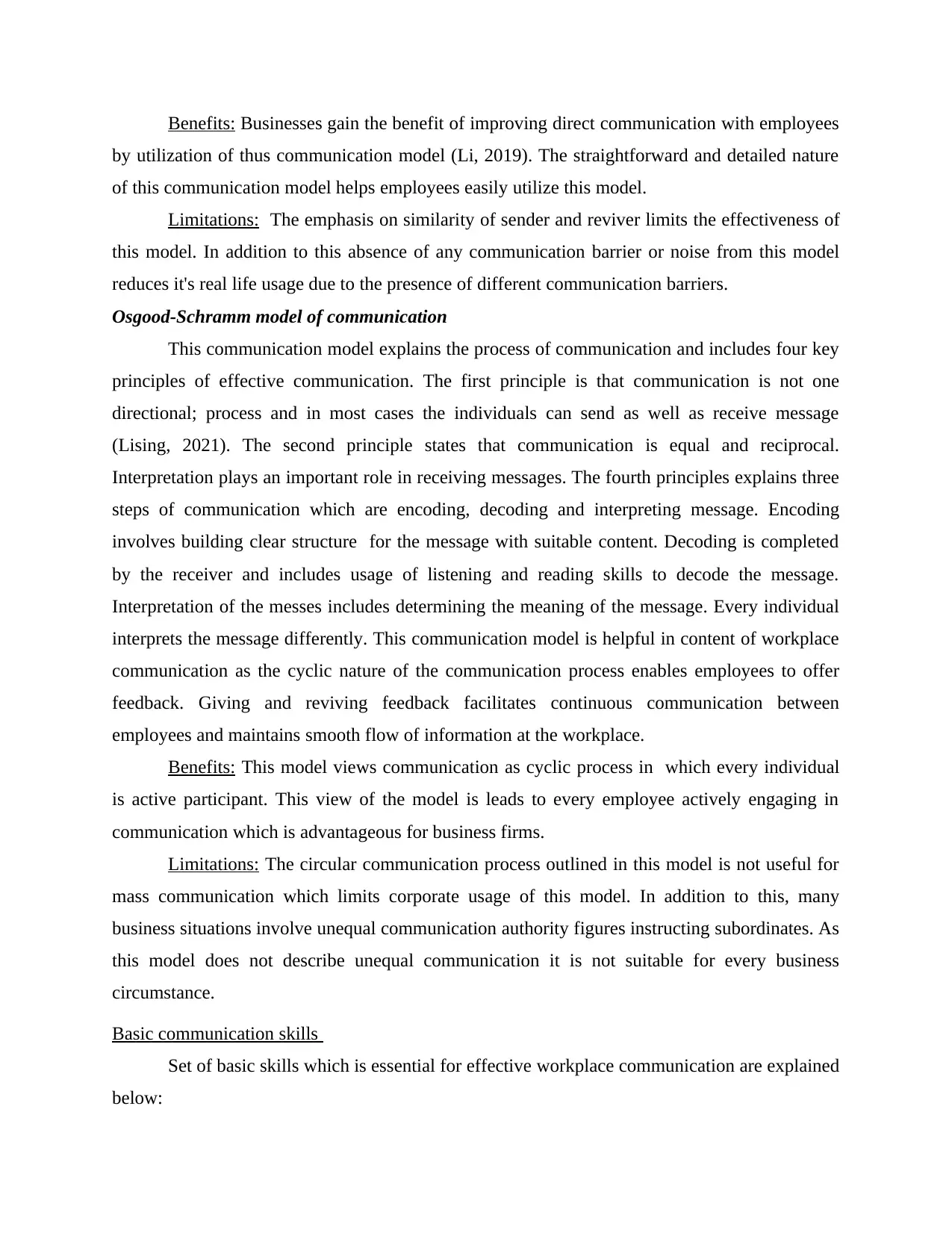
Benefits: Businesses gain the benefit of improving direct communication with employees
by utilization of thus communication model (Li, 2019). The straightforward and detailed nature
of this communication model helps employees easily utilize this model.
Limitations: The emphasis on similarity of sender and reviver limits the effectiveness of
this model. In addition to this absence of any communication barrier or noise from this model
reduces it's real life usage due to the presence of different communication barriers.
Osgood-Schramm model of communication
This communication model explains the process of communication and includes four key
principles of effective communication. The first principle is that communication is not one
directional; process and in most cases the individuals can send as well as receive message
(Lising, 2021). The second principle states that communication is equal and reciprocal.
Interpretation plays an important role in receiving messages. The fourth principles explains three
steps of communication which are encoding, decoding and interpreting message. Encoding
involves building clear structure for the message with suitable content. Decoding is completed
by the receiver and includes usage of listening and reading skills to decode the message.
Interpretation of the messes includes determining the meaning of the message. Every individual
interprets the message differently. This communication model is helpful in content of workplace
communication as the cyclic nature of the communication process enables employees to offer
feedback. Giving and reviving feedback facilitates continuous communication between
employees and maintains smooth flow of information at the workplace.
Benefits: This model views communication as cyclic process in which every individual
is active participant. This view of the model is leads to every employee actively engaging in
communication which is advantageous for business firms.
Limitations: The circular communication process outlined in this model is not useful for
mass communication which limits corporate usage of this model. In addition to this, many
business situations involve unequal communication authority figures instructing subordinates. As
this model does not describe unequal communication it is not suitable for every business
circumstance.
Basic communication skills
Set of basic skills which is essential for effective workplace communication are explained
below:
by utilization of thus communication model (Li, 2019). The straightforward and detailed nature
of this communication model helps employees easily utilize this model.
Limitations: The emphasis on similarity of sender and reviver limits the effectiveness of
this model. In addition to this absence of any communication barrier or noise from this model
reduces it's real life usage due to the presence of different communication barriers.
Osgood-Schramm model of communication
This communication model explains the process of communication and includes four key
principles of effective communication. The first principle is that communication is not one
directional; process and in most cases the individuals can send as well as receive message
(Lising, 2021). The second principle states that communication is equal and reciprocal.
Interpretation plays an important role in receiving messages. The fourth principles explains three
steps of communication which are encoding, decoding and interpreting message. Encoding
involves building clear structure for the message with suitable content. Decoding is completed
by the receiver and includes usage of listening and reading skills to decode the message.
Interpretation of the messes includes determining the meaning of the message. Every individual
interprets the message differently. This communication model is helpful in content of workplace
communication as the cyclic nature of the communication process enables employees to offer
feedback. Giving and reviving feedback facilitates continuous communication between
employees and maintains smooth flow of information at the workplace.
Benefits: This model views communication as cyclic process in which every individual
is active participant. This view of the model is leads to every employee actively engaging in
communication which is advantageous for business firms.
Limitations: The circular communication process outlined in this model is not useful for
mass communication which limits corporate usage of this model. In addition to this, many
business situations involve unequal communication authority figures instructing subordinates. As
this model does not describe unequal communication it is not suitable for every business
circumstance.
Basic communication skills
Set of basic skills which is essential for effective workplace communication are explained
below:
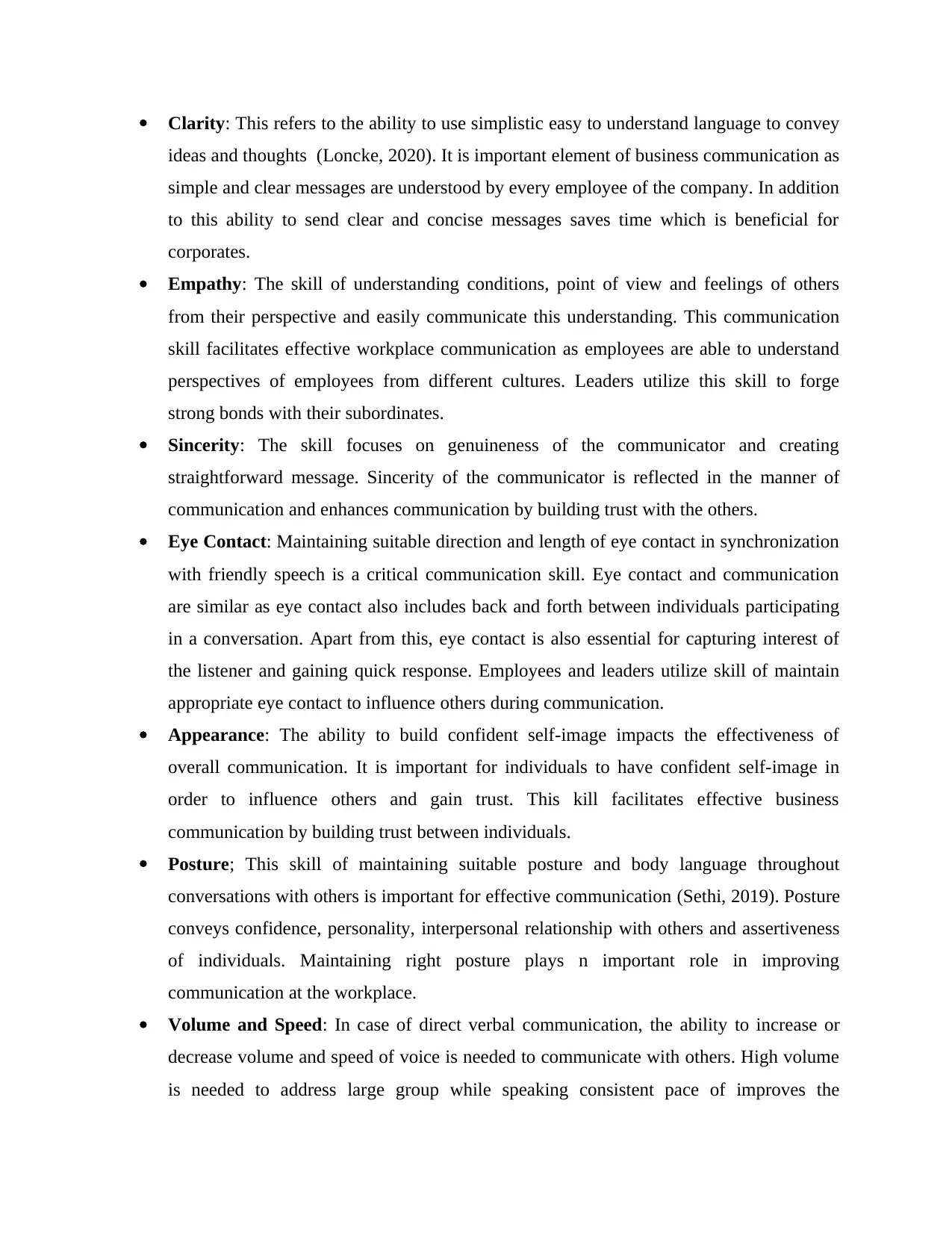
Clarity: This refers to the ability to use simplistic easy to understand language to convey
ideas and thoughts (Loncke, 2020). It is important element of business communication as
simple and clear messages are understood by every employee of the company. In addition
to this ability to send clear and concise messages saves time which is beneficial for
corporates.
Empathy: The skill of understanding conditions, point of view and feelings of others
from their perspective and easily communicate this understanding. This communication
skill facilitates effective workplace communication as employees are able to understand
perspectives of employees from different cultures. Leaders utilize this skill to forge
strong bonds with their subordinates.
Sincerity: The skill focuses on genuineness of the communicator and creating
straightforward message. Sincerity of the communicator is reflected in the manner of
communication and enhances communication by building trust with the others.
Eye Contact: Maintaining suitable direction and length of eye contact in synchronization
with friendly speech is a critical communication skill. Eye contact and communication
are similar as eye contact also includes back and forth between individuals participating
in a conversation. Apart from this, eye contact is also essential for capturing interest of
the listener and gaining quick response. Employees and leaders utilize skill of maintain
appropriate eye contact to influence others during communication.
Appearance: The ability to build confident self-image impacts the effectiveness of
overall communication. It is important for individuals to have confident self-image in
order to influence others and gain trust. This kill facilitates effective business
communication by building trust between individuals.
Posture; This skill of maintaining suitable posture and body language throughout
conversations with others is important for effective communication (Sethi, 2019). Posture
conveys confidence, personality, interpersonal relationship with others and assertiveness
of individuals. Maintaining right posture plays n important role in improving
communication at the workplace.
Volume and Speed: In case of direct verbal communication, the ability to increase or
decrease volume and speed of voice is needed to communicate with others. High volume
is needed to address large group while speaking consistent pace of improves the
ideas and thoughts (Loncke, 2020). It is important element of business communication as
simple and clear messages are understood by every employee of the company. In addition
to this ability to send clear and concise messages saves time which is beneficial for
corporates.
Empathy: The skill of understanding conditions, point of view and feelings of others
from their perspective and easily communicate this understanding. This communication
skill facilitates effective workplace communication as employees are able to understand
perspectives of employees from different cultures. Leaders utilize this skill to forge
strong bonds with their subordinates.
Sincerity: The skill focuses on genuineness of the communicator and creating
straightforward message. Sincerity of the communicator is reflected in the manner of
communication and enhances communication by building trust with the others.
Eye Contact: Maintaining suitable direction and length of eye contact in synchronization
with friendly speech is a critical communication skill. Eye contact and communication
are similar as eye contact also includes back and forth between individuals participating
in a conversation. Apart from this, eye contact is also essential for capturing interest of
the listener and gaining quick response. Employees and leaders utilize skill of maintain
appropriate eye contact to influence others during communication.
Appearance: The ability to build confident self-image impacts the effectiveness of
overall communication. It is important for individuals to have confident self-image in
order to influence others and gain trust. This kill facilitates effective business
communication by building trust between individuals.
Posture; This skill of maintaining suitable posture and body language throughout
conversations with others is important for effective communication (Sethi, 2019). Posture
conveys confidence, personality, interpersonal relationship with others and assertiveness
of individuals. Maintaining right posture plays n important role in improving
communication at the workplace.
Volume and Speed: In case of direct verbal communication, the ability to increase or
decrease volume and speed of voice is needed to communicate with others. High volume
is needed to address large group while speaking consistent pace of improves the
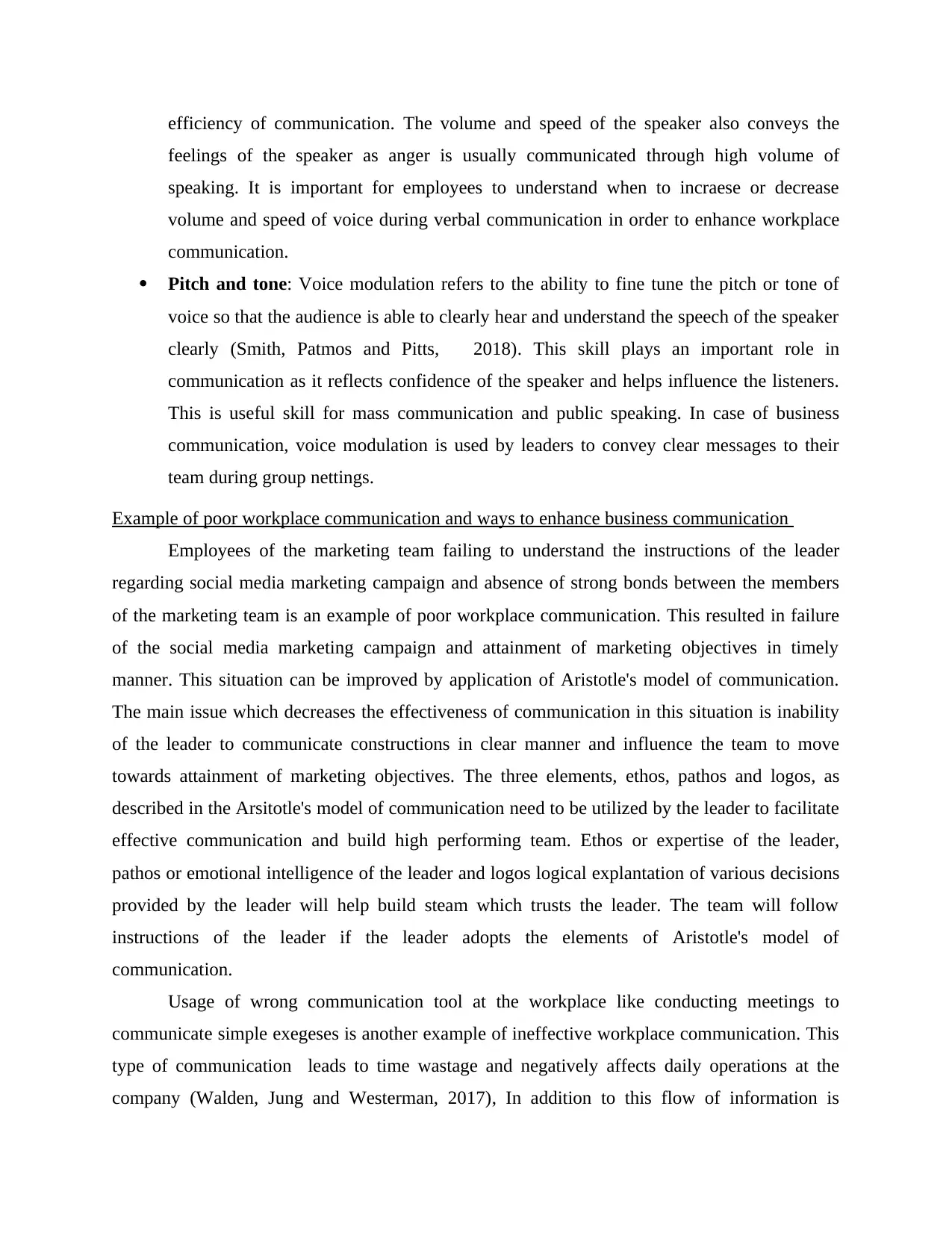
efficiency of communication. The volume and speed of the speaker also conveys the
feelings of the speaker as anger is usually communicated through high volume of
speaking. It is important for employees to understand when to incraese or decrease
volume and speed of voice during verbal communication in order to enhance workplace
communication.
Pitch and tone: Voice modulation refers to the ability to fine tune the pitch or tone of
voice so that the audience is able to clearly hear and understand the speech of the speaker
clearly (Smith, Patmos and Pitts, 2018). This skill plays an important role in
communication as it reflects confidence of the speaker and helps influence the listeners.
This is useful skill for mass communication and public speaking. In case of business
communication, voice modulation is used by leaders to convey clear messages to their
team during group nettings.
Example of poor workplace communication and ways to enhance business communication
Employees of the marketing team failing to understand the instructions of the leader
regarding social media marketing campaign and absence of strong bonds between the members
of the marketing team is an example of poor workplace communication. This resulted in failure
of the social media marketing campaign and attainment of marketing objectives in timely
manner. This situation can be improved by application of Aristotle's model of communication.
The main issue which decreases the effectiveness of communication in this situation is inability
of the leader to communicate constructions in clear manner and influence the team to move
towards attainment of marketing objectives. The three elements, ethos, pathos and logos, as
described in the Arsitotle's model of communication need to be utilized by the leader to facilitate
effective communication and build high performing team. Ethos or expertise of the leader,
pathos or emotional intelligence of the leader and logos logical explantation of various decisions
provided by the leader will help build steam which trusts the leader. The team will follow
instructions of the leader if the leader adopts the elements of Aristotle's model of
communication.
Usage of wrong communication tool at the workplace like conducting meetings to
communicate simple exegeses is another example of ineffective workplace communication. This
type of communication leads to time wastage and negatively affects daily operations at the
company (Walden, Jung and Westerman, 2017), In addition to this flow of information is
feelings of the speaker as anger is usually communicated through high volume of
speaking. It is important for employees to understand when to incraese or decrease
volume and speed of voice during verbal communication in order to enhance workplace
communication.
Pitch and tone: Voice modulation refers to the ability to fine tune the pitch or tone of
voice so that the audience is able to clearly hear and understand the speech of the speaker
clearly (Smith, Patmos and Pitts, 2018). This skill plays an important role in
communication as it reflects confidence of the speaker and helps influence the listeners.
This is useful skill for mass communication and public speaking. In case of business
communication, voice modulation is used by leaders to convey clear messages to their
team during group nettings.
Example of poor workplace communication and ways to enhance business communication
Employees of the marketing team failing to understand the instructions of the leader
regarding social media marketing campaign and absence of strong bonds between the members
of the marketing team is an example of poor workplace communication. This resulted in failure
of the social media marketing campaign and attainment of marketing objectives in timely
manner. This situation can be improved by application of Aristotle's model of communication.
The main issue which decreases the effectiveness of communication in this situation is inability
of the leader to communicate constructions in clear manner and influence the team to move
towards attainment of marketing objectives. The three elements, ethos, pathos and logos, as
described in the Arsitotle's model of communication need to be utilized by the leader to facilitate
effective communication and build high performing team. Ethos or expertise of the leader,
pathos or emotional intelligence of the leader and logos logical explantation of various decisions
provided by the leader will help build steam which trusts the leader. The team will follow
instructions of the leader if the leader adopts the elements of Aristotle's model of
communication.
Usage of wrong communication tool at the workplace like conducting meetings to
communicate simple exegeses is another example of ineffective workplace communication. This
type of communication leads to time wastage and negatively affects daily operations at the
company (Walden, Jung and Westerman, 2017), In addition to this flow of information is
Paraphrase This Document
Need a fresh take? Get an instant paraphrase of this document with our AI Paraphraser
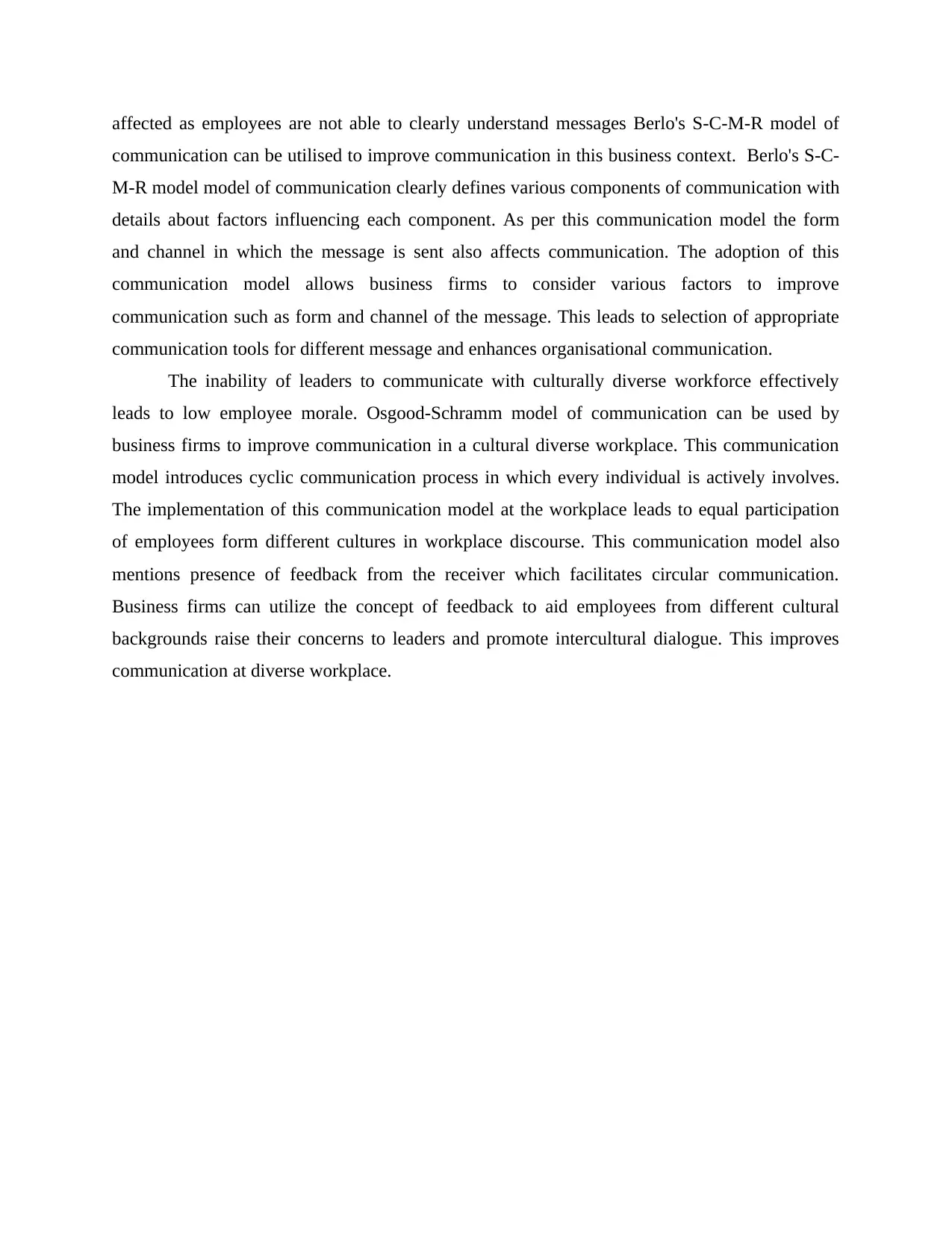
affected as employees are not able to clearly understand messages Berlo's S-C-M-R model of
communication can be utilised to improve communication in this business context. Berlo's S-C-
M-R model model of communication clearly defines various components of communication with
details about factors influencing each component. As per this communication model the form
and channel in which the message is sent also affects communication. The adoption of this
communication model allows business firms to consider various factors to improve
communication such as form and channel of the message. This leads to selection of appropriate
communication tools for different message and enhances organisational communication.
The inability of leaders to communicate with culturally diverse workforce effectively
leads to low employee morale. Osgood-Schramm model of communication can be used by
business firms to improve communication in a cultural diverse workplace. This communication
model introduces cyclic communication process in which every individual is actively involves.
The implementation of this communication model at the workplace leads to equal participation
of employees form different cultures in workplace discourse. This communication model also
mentions presence of feedback from the receiver which facilitates circular communication.
Business firms can utilize the concept of feedback to aid employees from different cultural
backgrounds raise their concerns to leaders and promote intercultural dialogue. This improves
communication at diverse workplace.
communication can be utilised to improve communication in this business context. Berlo's S-C-
M-R model model of communication clearly defines various components of communication with
details about factors influencing each component. As per this communication model the form
and channel in which the message is sent also affects communication. The adoption of this
communication model allows business firms to consider various factors to improve
communication such as form and channel of the message. This leads to selection of appropriate
communication tools for different message and enhances organisational communication.
The inability of leaders to communicate with culturally diverse workforce effectively
leads to low employee morale. Osgood-Schramm model of communication can be used by
business firms to improve communication in a cultural diverse workplace. This communication
model introduces cyclic communication process in which every individual is actively involves.
The implementation of this communication model at the workplace leads to equal participation
of employees form different cultures in workplace discourse. This communication model also
mentions presence of feedback from the receiver which facilitates circular communication.
Business firms can utilize the concept of feedback to aid employees from different cultural
backgrounds raise their concerns to leaders and promote intercultural dialogue. This improves
communication at diverse workplace.
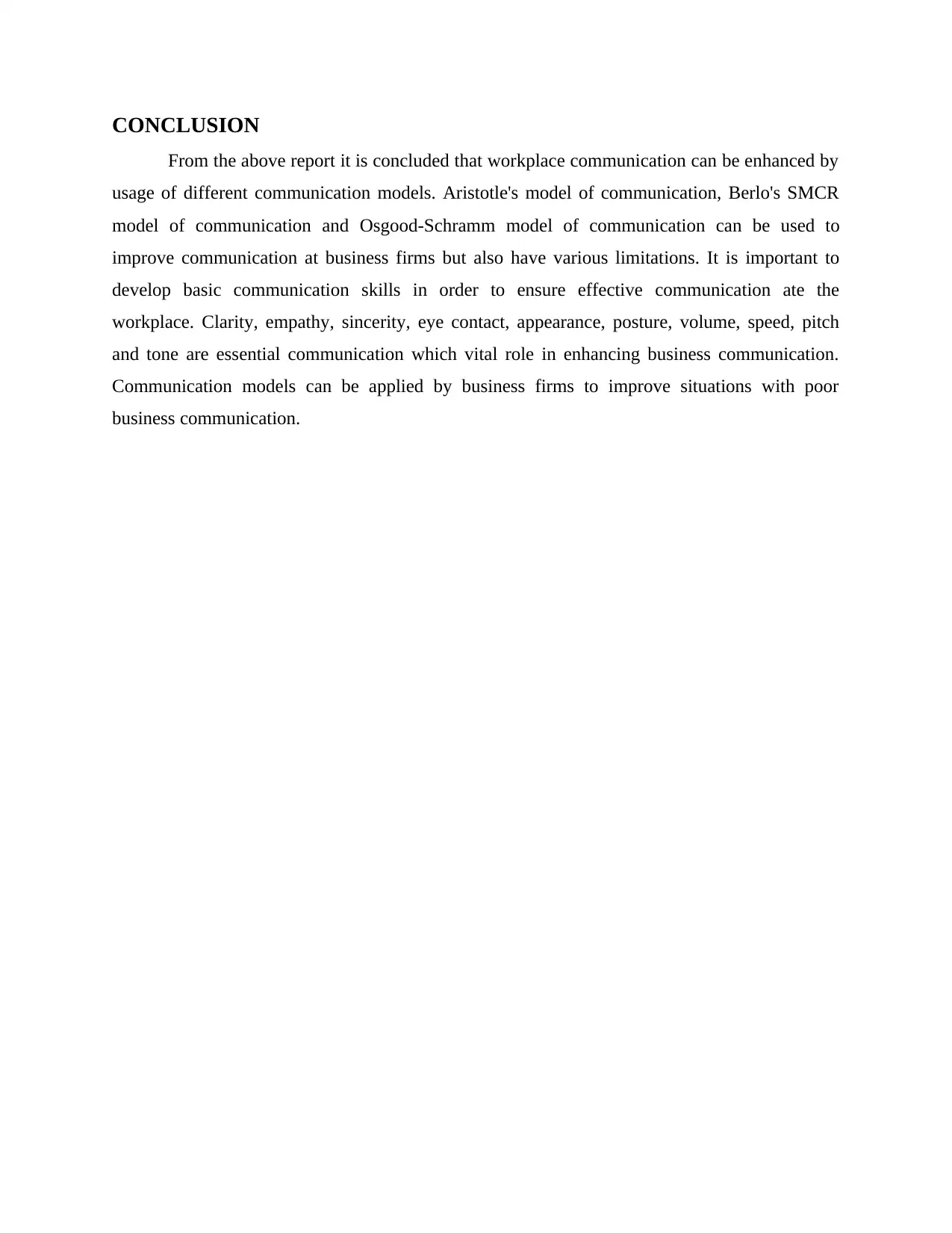
CONCLUSION
From the above report it is concluded that workplace communication can be enhanced by
usage of different communication models. Aristotle's model of communication, Berlo's SMCR
model of communication and Osgood-Schramm model of communication can be used to
improve communication at business firms but also have various limitations. It is important to
develop basic communication skills in order to ensure effective communication ate the
workplace. Clarity, empathy, sincerity, eye contact, appearance, posture, volume, speed, pitch
and tone are essential communication which vital role in enhancing business communication.
Communication models can be applied by business firms to improve situations with poor
business communication.
From the above report it is concluded that workplace communication can be enhanced by
usage of different communication models. Aristotle's model of communication, Berlo's SMCR
model of communication and Osgood-Schramm model of communication can be used to
improve communication at business firms but also have various limitations. It is important to
develop basic communication skills in order to ensure effective communication ate the
workplace. Clarity, empathy, sincerity, eye contact, appearance, posture, volume, speed, pitch
and tone are essential communication which vital role in enhancing business communication.
Communication models can be applied by business firms to improve situations with poor
business communication.
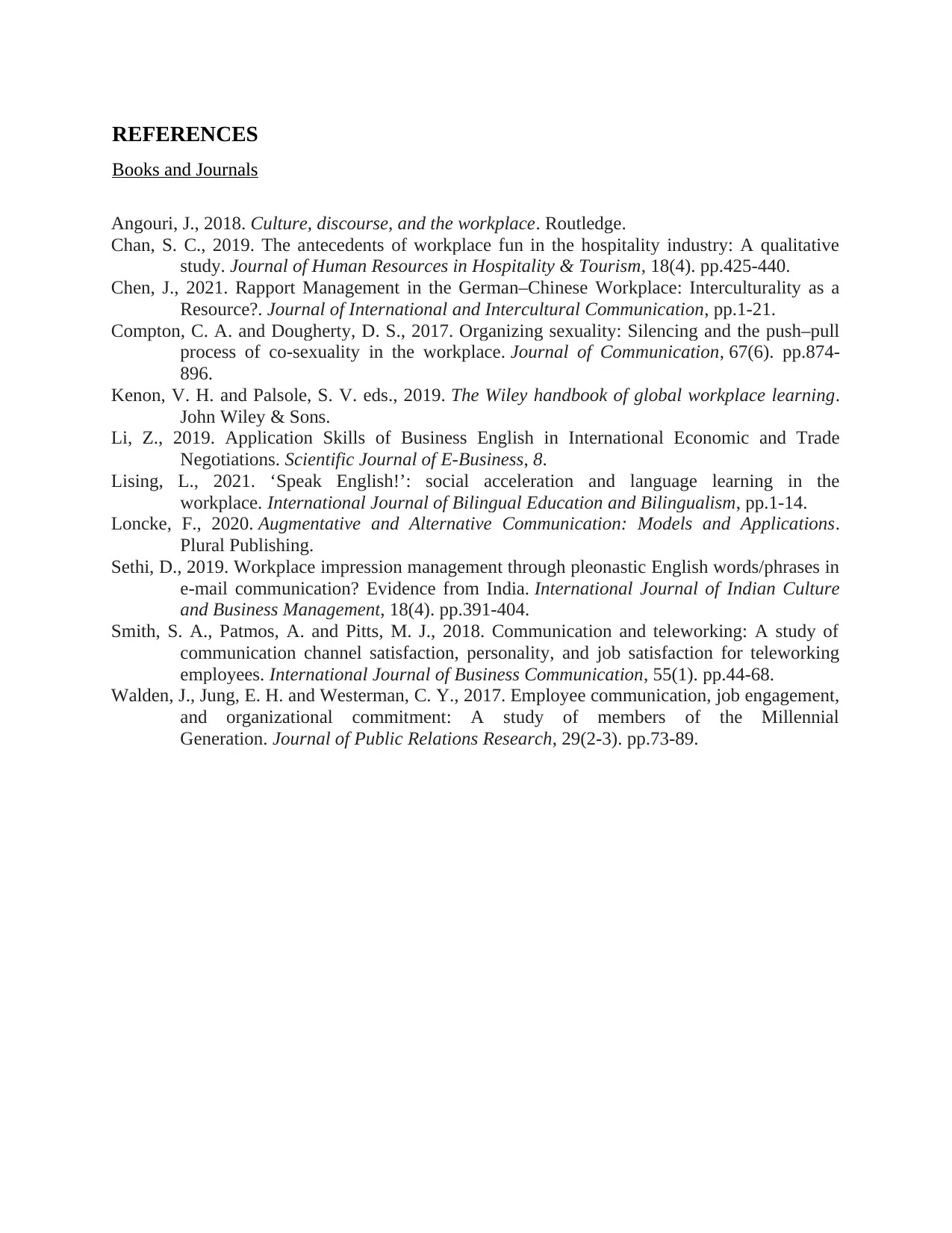
REFERENCES
Books and Journals
Angouri, J., 2018. Culture, discourse, and the workplace. Routledge.
Chan, S. C., 2019. The antecedents of workplace fun in the hospitality industry: A qualitative
study. Journal of Human Resources in Hospitality & Tourism, 18(4). pp.425-440.
Chen, J., 2021. Rapport Management in the German–Chinese Workplace: Interculturality as a
Resource?. Journal of International and Intercultural Communication, pp.1-21.
Compton, C. A. and Dougherty, D. S., 2017. Organizing sexuality: Silencing and the push–pull
process of co-sexuality in the workplace. Journal of Communication, 67(6). pp.874-
896.
Kenon, V. H. and Palsole, S. V. eds., 2019. The Wiley handbook of global workplace learning.
John Wiley & Sons.
Li, Z., 2019. Application Skills of Business English in International Economic and Trade
Negotiations. Scientific Journal of E-Business, 8.
Lising, L., 2021. ‘Speak English!’: social acceleration and language learning in the
workplace. International Journal of Bilingual Education and Bilingualism, pp.1-14.
Loncke, F., 2020. Augmentative and Alternative Communication: Models and Applications.
Plural Publishing.
Sethi, D., 2019. Workplace impression management through pleonastic English words/phrases in
e-mail communication? Evidence from India. International Journal of Indian Culture
and Business Management, 18(4). pp.391-404.
Smith, S. A., Patmos, A. and Pitts, M. J., 2018. Communication and teleworking: A study of
communication channel satisfaction, personality, and job satisfaction for teleworking
employees. International Journal of Business Communication, 55(1). pp.44-68.
Walden, J., Jung, E. H. and Westerman, C. Y., 2017. Employee communication, job engagement,
and organizational commitment: A study of members of the Millennial
Generation. Journal of Public Relations Research, 29(2-3). pp.73-89.
Books and Journals
Angouri, J., 2018. Culture, discourse, and the workplace. Routledge.
Chan, S. C., 2019. The antecedents of workplace fun in the hospitality industry: A qualitative
study. Journal of Human Resources in Hospitality & Tourism, 18(4). pp.425-440.
Chen, J., 2021. Rapport Management in the German–Chinese Workplace: Interculturality as a
Resource?. Journal of International and Intercultural Communication, pp.1-21.
Compton, C. A. and Dougherty, D. S., 2017. Organizing sexuality: Silencing and the push–pull
process of co-sexuality in the workplace. Journal of Communication, 67(6). pp.874-
896.
Kenon, V. H. and Palsole, S. V. eds., 2019. The Wiley handbook of global workplace learning.
John Wiley & Sons.
Li, Z., 2019. Application Skills of Business English in International Economic and Trade
Negotiations. Scientific Journal of E-Business, 8.
Lising, L., 2021. ‘Speak English!’: social acceleration and language learning in the
workplace. International Journal of Bilingual Education and Bilingualism, pp.1-14.
Loncke, F., 2020. Augmentative and Alternative Communication: Models and Applications.
Plural Publishing.
Sethi, D., 2019. Workplace impression management through pleonastic English words/phrases in
e-mail communication? Evidence from India. International Journal of Indian Culture
and Business Management, 18(4). pp.391-404.
Smith, S. A., Patmos, A. and Pitts, M. J., 2018. Communication and teleworking: A study of
communication channel satisfaction, personality, and job satisfaction for teleworking
employees. International Journal of Business Communication, 55(1). pp.44-68.
Walden, J., Jung, E. H. and Westerman, C. Y., 2017. Employee communication, job engagement,
and organizational commitment: A study of members of the Millennial
Generation. Journal of Public Relations Research, 29(2-3). pp.73-89.
1 out of 10
Related Documents
Your All-in-One AI-Powered Toolkit for Academic Success.
+13062052269
info@desklib.com
Available 24*7 on WhatsApp / Email
![[object Object]](/_next/static/media/star-bottom.7253800d.svg)
Unlock your academic potential
© 2024 | Zucol Services PVT LTD | All rights reserved.



